Svalbard Circumnavigation | Ocean Albatros
10 Days
From AUD 10,300
STYLE: Small Ship Expedition Cruise
Trip Code: ACABSC25
DIFFICULTY RATING: 2 (light adventure)
Start: Longyearbyen, Svalbard
Finish: Longyearbyen, Svalbard
SHIP: Ocean Albatros
 Destination
Destination
Svalbard
 Departure Date
Departure Date
18/06/2025
 Meals
Meals
All meals on board the ship
 Transport
Transport
Optional return flight package from Oslo, contact us for more details
 Accommodation
Accommodation
Cabin on board a ship
Enquire Now


 Included Sightseeing
Included Sightseeing
Daily Arctic Excursions in location, Zodiac Cruising, Onboard Expert Lectures & Briefings by the Experienced Expedition Team
NOTE: Itinerary is subject to change depending on weather & ice conditions
OVERVIEW
The ultimate bucket-list expedition, circumnavigating Svalbard, is the aim of this journey! While on this incredible journey across the high Arctic, we will take in the breathtaking grandeur of Svalbard with polar bears, whales, walruses, and millions of seabirds. We will travel through one of the largest protected regions in the Arctic, north-west Spitzbergen, before arriving at the polar bear's preferred summer home. We will approach as near as we can to the pack ice north of Svalbard, a continuously moving sea and ice wilderness that spans to the North Pole and beyond, as we cruise to 80 degrees north. The warm Gulf Stream keeps the numerous breathtaking spots along the shores of Svalbard's islands passable, but the exact course of the journey and the extent of our northern reach are at the mercy of Mother Nature.
Wildlife like Arctic foxes, geese, and reindeer are busy storing energy for the harsh northern winter throughout the brief summer. The cliffs glisten with life, with innumerable birds populating every available surface, striving to raise the next generation of Arctic seabirds before they are prepared to go from their nests. Brunnich's guillemots, black guillemots, and razorbills fishing in our ship's wake are examples of the abundant bird life. On land, numerous whales and seals can be seen feeding along the edges of the pack ice and the beaches, while massive walruses relish the brief Arctic summer. We can see wildlife up close and safely in our fleet of Zodiac boats. We can make regular shore landings and take little, exploratory excursions around the fjords and glacier vistas thanks to the Zodiacs. We explore every location, including distant, desolate beaches, glacier fronts, and historical locations!
PLEASE NOTE: Pricing is subject to change and availability at the time of booking. Contact Us for more information.
ITINERARY

Board your flight in Norway and arrive in Longyearbyen, Svalbard - the world's northernmost... everything! This remarkable little city is not only the northernmost town in the world (if one excludes the tiny research community of Ny-Ålesund, slightly further north on Svalbard), but also hosts the world's northernmost civilian airport, schools, bank and supermarket. The town's rugged frontier edge belies a core of warm Nordic hospitality and coziness - hyggligt, as we say in Denmark!
Immediately after landing in Longyearbyen, you find yourself in a different world. The chilly Arctic breeze can be felt as soon as you step onto the tarmac, and the famous signpost outside the terminal reminds visitors how far north they really are; as well as to keep watch for bears! The snow-capped mountain Hjorthfjellet looms over the airport on the far side of Adventfjorden, and off in the distance can be seen the saw-toothed peaks and languid glaciers of northern Spitzbergen.
After arrival, you will board the awaiting Ocean Albatros. After our mandatory safety briefing and lifeboat drill, head onto the outer decks to enjoy a glass of champagne while watching your expedition vessel leave civilisation behind... And set a course for adventure!

During the ‘night’ (what is night, when the sun never sets?), Ocean Albatros will have repositioned past the saw-toothed mountains of Prins Karls Forland and arrived in magnificent Kongsfjord. Surrounded by craggy mountains, bounded by the magnificent Kongsbreen and Kongvegen Glaciers, and crowned by the Three Crowns (a set of pyramidal mountains said to represent the monarchies of Norway, Sweden and Denmark), this is surely one of the most beautiful and tranquil corners anywhere in the world.
Our first landing will be at the small settlement of Ny Ålesund. Situated further north than Longyearbyen, Ny-Ålesund is Earth's northernmost settlement, if a group of scientific stations, a post office and a single shop open for a few hours can be described as such... You will have to judge for yourself!
These islands' geographical location has made them the staging post for exploratory and scientific expeditions for centuries - a proud legacy which continues to this day. The setting is spectacular, and the scientific projects are as fascinating as the history of the town, which has hosted the Nobile, the Norge and the Fram, Amundsen, Nansen and Nordenskiöld, all legends of polar exploration who passed this lonely outpost seeking to push the boundaries of humanity. The remnants of these expeditions (such as the mooring mast of the Norge) can still be seen today.
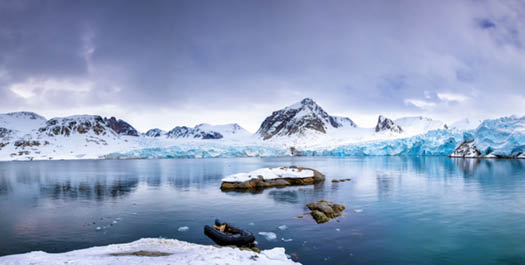
One of the largest protected wilderness areas in Europe, North West Svalbard was declared a national park in 1973. The area is famed for its history, which documents some of the earliest human arrivals on Svalbard. While Norse explorers may have sighted these icy shores during the Viking Age, the first definite arrival was the expedition of William Barents, the legendary Dutch explorer for whom the Barents Sea is named. While now protected from human distruption, when Barents arrived in 1596, he noted the vast numbers of whales and seals which were soon prey to English and Dutch whalers, who arrived within a decade of Barents to pillage the area's wildlife. The area occupies the triple point between land, sea and ice, and as such was the perfect location from which to harvest the gentle giants of the oceans. Sites used to dismember whale carcasses and render them for their precious oil include the Dutch settlement of Smeerenburg, where the remains of 16th Century blubber ovens and building foundations can still be seen. Other sites such as nearby Ytre Norskøya record the darker side of this industrialised slaughter, where hundreds of young men who hoped to make their fortunes are buried thousands of miles from home.
Today, all that remains from this period of history are bones and the scant remnants of human habitation. Slowly reclaimed by creeping Arctic nature, the region is now a nature lovers paradise. Tiny Arctic poppies and purple saxifrage defy the brutal conditions to flower in the brief summer, while geese, eider ducks and other seabirds return to the island to raise their young. Walrus can be found hauled out on beaches, and we must always be on careful lookout for wandering polar bears in this now again wild region.

An icy breeze touches your exposed cheeks. The scent of snow and sea fills your nostrils. Sunlight reflects off the floating ice, illuminating the clouds overhead. Enter an environment like no other, the vast shape-shifting realm of floating ice which crowns our planet. The vast ever-changing ice pack to the north of Svalbard stretches from this already isolated archipelago to the North Pole, and onwards across the Arctic Ocean towards the northern shores of Chukotka and Alaska.
The Arctic ice pack is one of Earth's largest habitats, although unlike most it varies hugely year on year, expanding in winter and retreating in summer. The location of the sea ice around Svalbard can also vary wildly - however, your Expedition Leader will work hard to maximise our chances of finding and exploring this impossibly remote environment. At first glance, this stark white wilderness seems barren, empty and lifeless. This icy wilderness holds on to its mysteries, and of course wildlife sightings are at the whims of Mother Nature. With a little perseverance however, the ice reveals its secrets.
As Ocean Albatros pushes through the narrow channels in the ice, tiny cod-like fish can be seen silhouetted against the ice in the clear water. Kittiwakes and Gloucous Gulls follow the vessel as it disturbs the water. Further out on the ice, black dots appear; moving closer, they resolve into seals, basking on the ice. A plume of water reflects the sunshine - a pod of belugas perhaps, or maybe even the vast gentle bowhead whale crushing the ice from below as its massive body surfaces. There, beyond the banks of rucked ice - a yellowish dot pads along the ice, the head swinging from side to side: the King of the Arctic continues his never-ending quest for prey. This is the kingdom of the polar bear, the vast icy wastes at the top of the world.
At the end of the day, we will start cruising towards the Hinlopen Strait that divides Spitsbergen and Nordaustlandet.

From the icy wilderness of the pack ice, we will head back towards land, cruising into the Hinlopen Strait. If the weather is on “our side” we may have a good view of the steep cliffs of Alkefjellet. The area is home to a dense congregation of Brünnichs guillemots - one of the largest colonies in the world. There are so many birds that hardly an inch is free! Nesting Brünnich's guillemots and other auks crowd the cliffs, while predatory skuas and gulls cruise the skies above, constantly on the lookout for their next meal. During the raucous summer the breeding pairs offer a wild view of frantic activity, both along the cliffs and in the sea in front - one of nature's most spectacular sights!
More wildlife awaits us as we land on the polar desert landscapes of Nordaustlandet. Although the polar desert landscapes of this region appear stark and barren, they are wildly beautiful - unearthly plantless landscapes illuminated by the weak Arctic sunlight. However, it is in the marine environment where Svalbard's biodiversity is richest. Walrus haul their vast bodies onto flat beaches to rest, where they snuggle together for warmth and protection. Belugas frolic in large pods in the waters off the coast, harvesting fish and crustaceans from the seabed, and further offshore the vast gentle baleen whales can sometimes be seen feasting upon copepods and small fish.

As we continue to venture around these remarkable islands, we arrive in Southeast Svalbard - a region where the cold easterly polar waters collide with the last tepid gasp of the Gulf Stream. If the ice is passable, we can make it through the southern edge of the Hinlopen Strait and cruise through Freemansundet, which separates Barentsøya and Edgeøya. We enjoy the views of the massive Kapp Lee as we exit the Strait.
We will aim to land on Edgeøya, Svalbard's third largest island. Vast piles of snow-bleached bones on the island's beaches bear witness to the systematic and industrial-scale slaughter of walrus and beluga in their thousands. The earliest humans on the islands (mainly English and Dutch whalers and Russian Pomor trappers) had little regard for conservation, seeking only profit, a situation which continued well into the 19th century. Thankfully all wildlife on Svalbard is now protected by law, and vast tracts of the archipelago are designated as nature reserves and National Parks - some of the largest and richest in the world!
Further east on Edgeøya, sites include the walrus colonies of Andréetangen and Kapp Lee, and the spectacular raised shorelines and bird colonies of Sundneset. From these remote shores, we will cruise around Sørkapp and back towards Spitzbergen, the largest island of Svalbard.
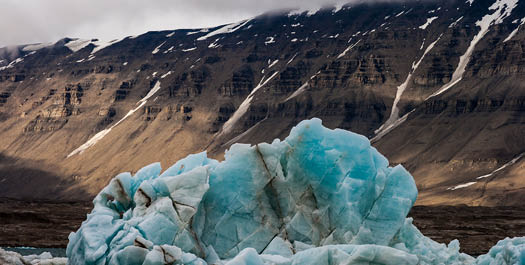
Having passed the southern tip of Spitsbergen we arrive back into the greener warmer regions of this Arctic wilderness. The southwest coast of Svalbard is washed by warmer water coming up through the Atlantic, so winter ice generally retreats first from this reagion. This allows us to enter the southern fjords of Bellsund and Hornsund - easily some of the most spectacular regions of this stunning archipelago. Throughout this maze of fjords and islands, birds cluster together on high cliffs and reindeer graze on the fertile slopes below, while icebergs drift by from the various large glaciers in the area. Tiny calico snow buntings flit between crags, while perfectly camouflaged purple sandpipers scamper along the shore. Look higher up on the vegetated slopes, and there - greyish white 'boulders' move and resolve themselves into sheep-sized reindeer: the unique subspecies native to Svalbard. A flash of bluish-black, and the screeches of nearby birds herald the arrival of the Arctic fox, the only native land predator on Svalbard (the polar bear being classified as a marine mammal).
The mountaintops are most often covered by dense clouds and the East-Spitsbergen current often leads pack ice into the mouths of the fjords. With a huge variety of landing sites to explore, this region is without doubt one of the most exciting and diverse regions of Svallbard! Options to explore in the area include the huge bird cliffs of Alkhjornet and Vårsolbukta, and the historical sites of Calypsobyen and Bambsebu, where prospectors, trappers and a range of other adventurers attempted to make their fortunes.
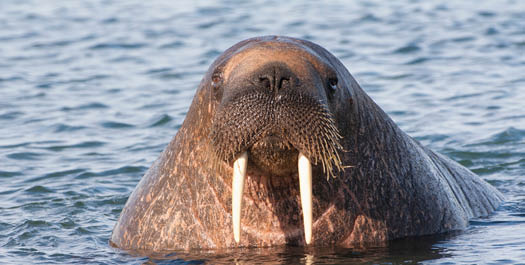
During the night we will enter Forlandssundet, the strait which separates Prince Karls Forland from Spitsbergen. Our destinations may include Poolepynten (Poole Point), a small headland named after the British whaler Jonas Poole. Today the area is inhabited by herds of walruses who can be seen (and smelled!) from a distance. The large mammals flaunt their tusks and whiskers, as well as their considerable bulk. The remote beaches, rugged mountains and tundra plains of the region positively beg to be explored!
From Forlandsundet, we will return southwards during the afternoon towards the town of Longyearbyen, all the while on the lookout for wildlife and spectacular views as we return to civilisation.
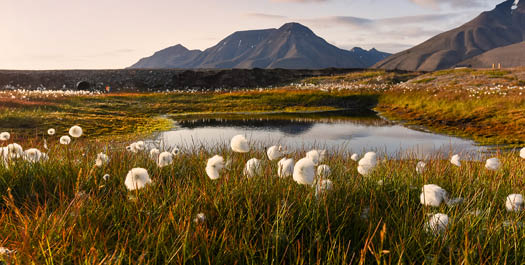
During the evening, the Ocean Albatros will reposition to return to the port of Longyearbyen. Even this small town will feel like a metropolis after days of isolation in the wilderness of the Arctic!
After enjoying exploring Longyearbyen and a fond farewell to the crew and fellow guests of Ocean Albatros, return to Svalbard Airport and join your flight back to the Norwegian mainland- with memories to last a lifetime.
Please note: Cruise itinerary is subject to change depending on weather conditions, ice conditions and other factors.

Ocean Albatros
Undertaking it's first sailing in 2023 the Ocean Albatros features the latest in X-Bow hull technology. With a total of 94 comfortable staterooms and suites, all with unobstructed views, the Ocean Albatros is one of the most popular expedition vessels in polar waters. Featuring two restaurants, a wellness area, Nordic bar, an open deck dining facility, modern lecture lounge and a number of other state-of-the-art amenities, the Albatros provides the ultimate expedition experience. Boasting up to 50% less emissions than traditional polar vessels, the Albatros provides peace of mind in regard to comfort and sustainability for our guests. The Albatros also comes with a unique panorama sauna and a total of 12 dedicated solo travel cabins without single supplement. Please note - Deckplan changes after 2025 Arctic Season
Ice Class:
Length: 104.4m
Breadth: 18.4mMax
Draft: Cruising
Speed:
Electricity: Passenger
Capacity:189
View Ship Details
Accommodation
We believe that appropriate accommodation should add to the authentic travel experience, as well as providing utmost enjoyment. For that reason our accommodation is scrutinised by our staff on the ground frequently, ensuring the properties adhere to our high standards. This key will help you understand the levels of accommodation available on this tour.

Standard
Comfortable properties with dependable facilities and service.

Superior
Comfortable properties with dependable facilities and service.

Deluxe
Luxurious properties with impeccable facilities and service.
OPTIONAL ACTIVITIES
Optional Activities vary for each itinerary. Limited spaces available. Contact your Destination Specialist for pricing & availability.
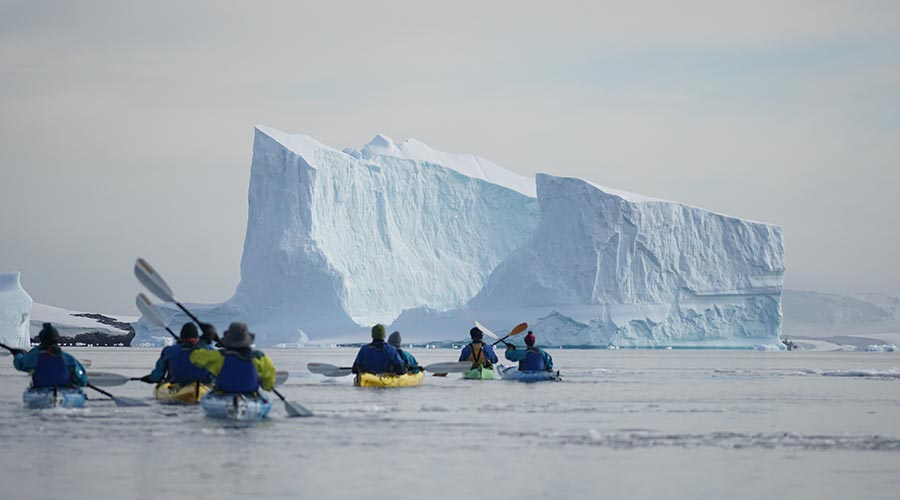
Kayaking
Experience the unforgettable thrill and serenity of kayaking in Antarctica as part of a small, expertly guided paddling group.
Learn MorePricing per person & date
| Svalbard Circumnavigation | Ocean Albatros from AUD 10,300 | ||
| Departing | Ending | Duration |
|---|---|---|
| 18 Jun 2025 | 27 Jun 2025 | 10 |
Important Information
Prices are based on per person, and may be based on quad/triple/twin share.
Prices are correct at time of publishing but are subject to change at any time.
Itinerary is subject to change depending on weather and ice conditions.
INCLUSIONS
Cabin accommodation on board vessel
All meals whilst on board
Dinner Drinks Package
Guiding and lectures by experienced expedition crew
All scheduled landings and excursions by zodiac*
Landing fees
Pre and post cruise and ferry transfers
Digital visual journal link after the voyage, including voyage log, gallery, species list, and more
EXCLUSIONS
Optional Transfer Package: Flights between Oslo - Longyearbyen - Oslo and Group Transfer between Longyearbyen Airport and the vessel. To be booked 11 months prior departure at additional cost.Extra excursions and activities not mentioned in the itinerary
International Flights
Meals not on board the ship
Beverages (other than coffee and tea and dinner-drink package)
All items of a personal nature
Customary gratuities for staff/crew
Any pre or post cruise accommodation
Any pre or post cruise travel extensions
Travel insurance
- 2 (light adventure)
Subject to availability on request for some cabin categories. Contact us for more details.
Departure Date, Fuel Surcharges, Cabin Category, Currency Fluctuations, Seasonality & Availability.







